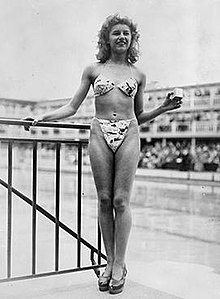History of the bikini
Illustrations of women wearing bikini-like garments during competitive athletic events in the Roman era have been found in several locations, the most famous of which is at Villa Romana del Casale.
[3] In the Chalcolithic era of around 5600 BC, the mother-goddess of Çatalhöyük, a large ancient settlement in southern Anatolia, was depicted astride two leopards while wearing a bikini-like costume.
[7] Artwork dating back to the Diocletian period (286–305 AD) in Villa Romana del Casale, Sicily, excavated by Gino Vinicio Gentili in 1950–60, depicts women in garments resembling bikinis in mosaics on the floor.
[10] In the artwork "Coronation of the Winner" done in floor mosaic in the Chamber of the Ten Maidens (Sala delle Dieci Ragazze in Italian[11]) the bikini girls are depicted weight-lifting, discus throwing, and running.
[8] Some academics maintain that the nearby image of Eros, the primordial god of lust, love, and intercourse, was added later, demonstrating the owner's predilections and strengthening the association of the bikini with the erotic.
[16] Prostitution, skimpy clothes and athletic bodies were related in ancient Rome, as images were found of female sex workers exercising with dumbbells/clappers and other equipment wearing costumes similar to the Bikini Girls.
A photograph of the mosaic was used by Sarah Pomeroy, Professor of Classics at Hunter College and the Graduate Center, City University of New York, in the 1994 British edition of her book Goddesses, Whores, Wives, and Slaves to emphasize a similar identification.
[21] The exercising bikini girls from Piazza Armerina wear subligaria, scanty briefs made as a dainty version of a man's perizoma, and a strophium band about the breasts, often referred to in literature as just fascia, which can mean any kind of bandage.
Ovid, the writer ranked alongside Virgil and Horace as one of the three canonical poets of Latin literature, suggests the breastband or long strip of cloth wrapped around the breasts and tucked in the ends, is a good place to hide love-letters.
[23] Martial, a Latin poet from Hispania who published between AD 86 and 103, satirized a female athlete he named Philaenis, who played ball in a bikini-like garb quite bluntly, making her drink, gorge and vomit in abundance and hinting at her lesbianism.
In 1907, Australian swimmer and performer Annette Kellerman was arrested on a Boston beach for wearing a form-fitting sleeveless one-piece knitted swimming tights that covered her from neck to toe, a costume she adopted from England,[34] although it became accepted swimsuit attire for women in parts of Europe by 1910.
In 1942 the United States War Production Board issued Regulation L-85, cutting the use of natural fibers in clothing[51] and mandating a 10% reduction in the amount of fabric in women's beachwear.
Two-piece swimsuits without the usual skirt panel and other excess material started appearing in the US when the government ordered a 10% reduction in fabric used in woman's swimwear in 1943 as wartime rationing.
[59] Hollywood endorsed the new glamour with films such as Neptune's Daughter (1949) in which Esther Williams wore provocatively named costumes such as "Double Entendre" and "Honey Child".
[48] Williams, who also was an Amateur Athletic Union champion in the 100 meter freestyle (1939)[60] and an Olympics swimming finalist (1940),[61] also portrayed Kellerman in the 1952 film Million Dollar Mermaid (titled as The One Piece Bathing Suit in UK).
Keeping in line with the ultra-feminine look dominated by Dior, it evolved into a dress with cinched waists and constructed bustlines, accessorized with earrings, bracelets, hats, scarves, sunglasses, hand bags and cover-ups.
[63] Many of these pre-bikinis had fancy names like Double Entendre, Honey Child (to maximize small bosoms), Shipshape (to minimize large bosoms), Diamond Lil (trimmed with rhinestones and lace), Swimming In Mink (trimmed with fur across the bodice) and Spearfisherman (heavy poplin with a rope belt for carrying a knife), Beau Catcher, Leading Lady, Pretty Foxy, Side Issue, Forecast, and Fabulous Fit.
"[64][70][71] Not to be outdone by Heim, Réard hired his own skywriters three weeks later to fly over the French Riviera advertising his design as "smaller than the smallest bathing suit in the world.
"[73] After actress Brigitte Bardot gained international attention in 1953 as the bikini girl of the French Riviera, Paparazzi popularized revealing accidents or staged events with women's swimwear throughout the decade.
For one of many instances, a cheesecake photo of rising starlet Daliah Lavi adjusting her bikini after it broke while at a Rio de Janeiro swimming pool was widely circulated by Associated Press in 1959.
[90] Brigitte Bardot, photographed wearing similar garments on beaches during the Cannes Film Festival (1953) helped popularize the bikini in Europe in the 1950s and created a market in the US.
During the 1953 Cannes Film Festival, she worked with her husband and agent Roger Vadim, and garnered a lot of attention when she was photographed wearing a bikini on every beach in the south of France.
[104] In reaction to the introduction of the bikini in Paris, American swimwear manufacturers compromised cautiously by producing their own similar design that included a halter and a midriff-bottom variation.
[107] By the end of the decade a vogue for strapless styles developed, wired or bound for firmness and fit, along with a taste for bare-shouldered two-pieces called Little Sinners but it was the halterneck bikini that caused the most moral controversy because of its degree of exposure.
[134] In the 1983 film Return of the Jedi, Star Wars' Princess Leia Organa was captured by Jabba the Hutt and forced to wear a metal bikini complete with shackles.
[142][143] The costume shocked the conservative Indian audience,[144] but it also set a trend of bikini-clad actresses carried forward by Parveen Babi (in Yeh Nazdeekiyan, 1982[145]), Zeenat Aman (in Heera Panna 1973; Qurbani, 1980[145]) and Dimple Kapadia (in Bobby, 1973[145]) in the early 1970s.
[146] Wearing a bikini put her name in the Indian press as one of Bollywood's ten hottest actresses of all time,[147] and was a transgression of female identity through a reversal of the state of modesty, which functions as a signifier of femininity in Bombay films.
The new swimwear code was epitomized by surf star Malia Jones, who appeared on the June 1997 cover of Shape Magazine wearing a halter top two-piece for rough water.
[159] PETA used celebrities like Pamela Anderson, Traci Bingham and Alicia Mayer wearing a bikini made of iceberg-lettuce for an advertisement campaign to promote vegetarianism.
[157] According to Beth Dincuff Charleston, research associate at the Costume Institute of the Metropolitan Museum of Art, "The bikini represents a social leap involving body consciousness, moral concerns, and sexual attitudes.










